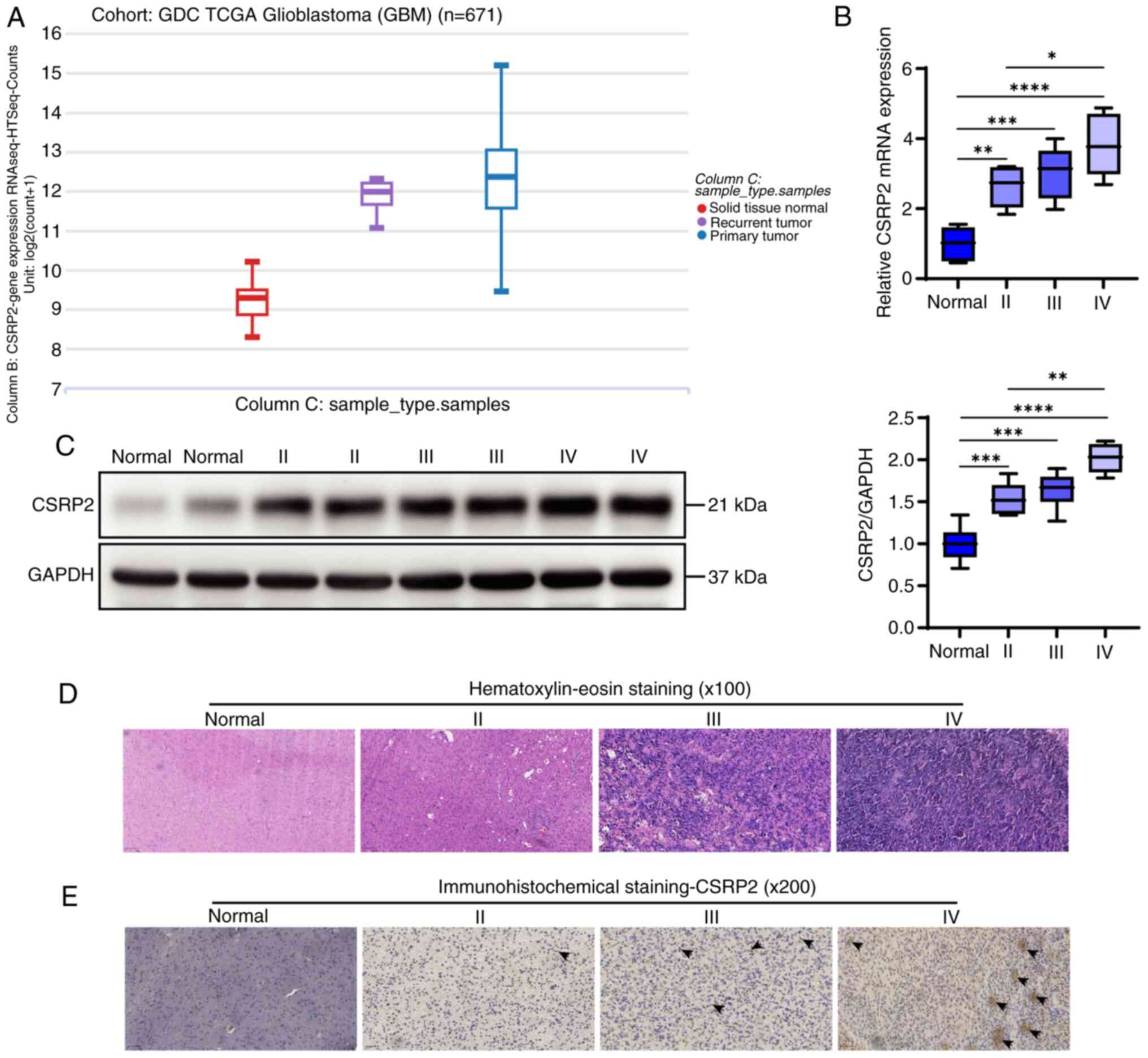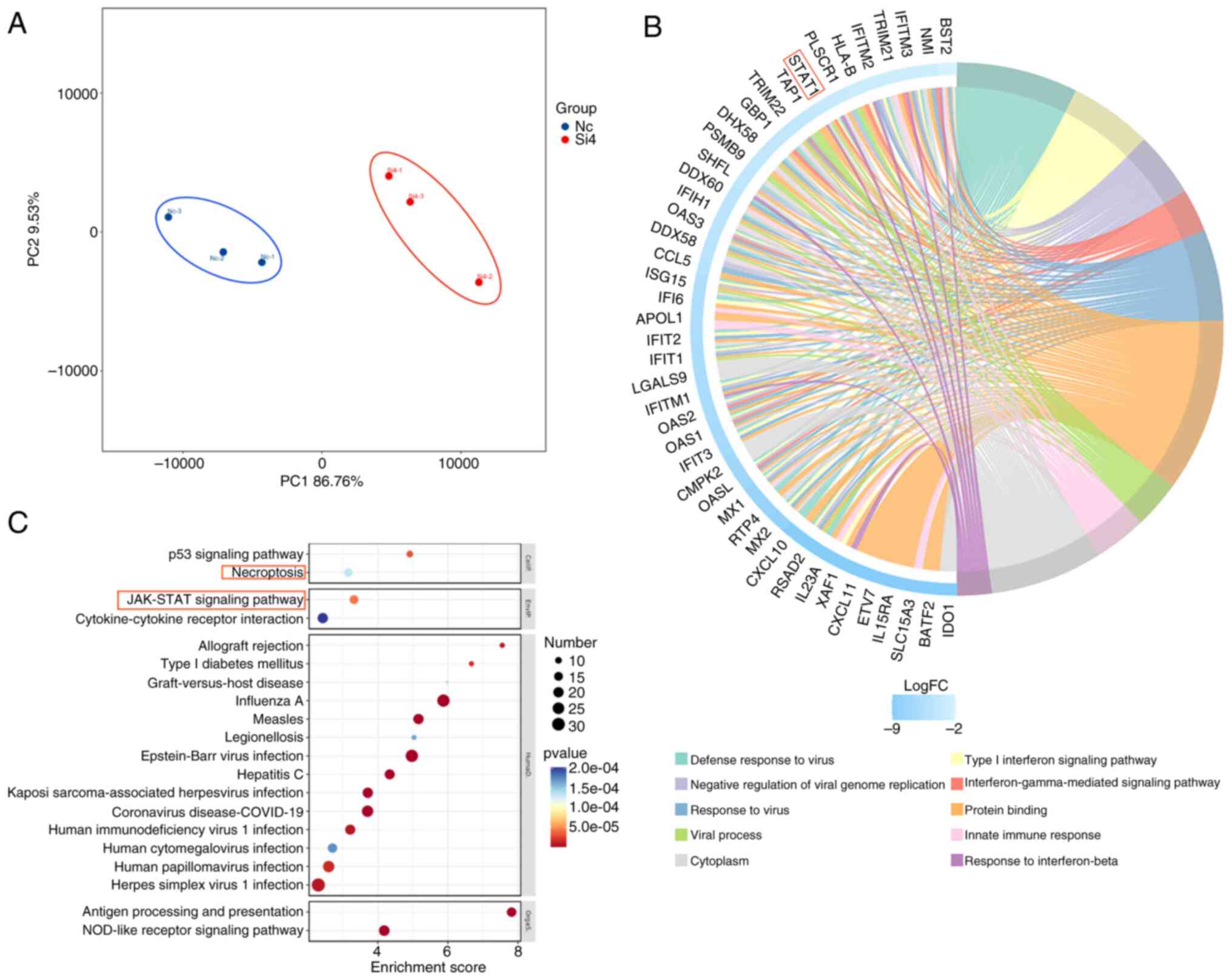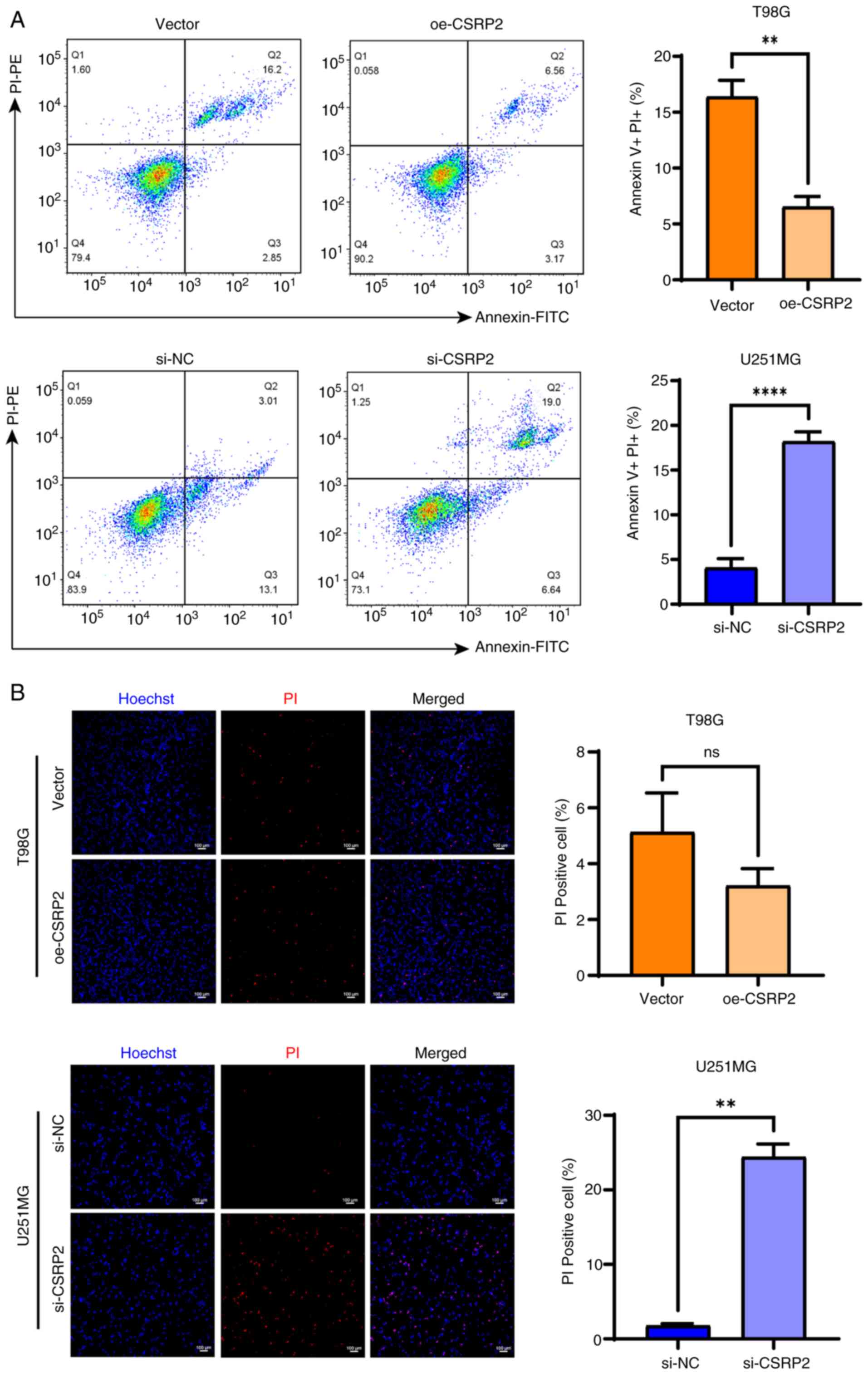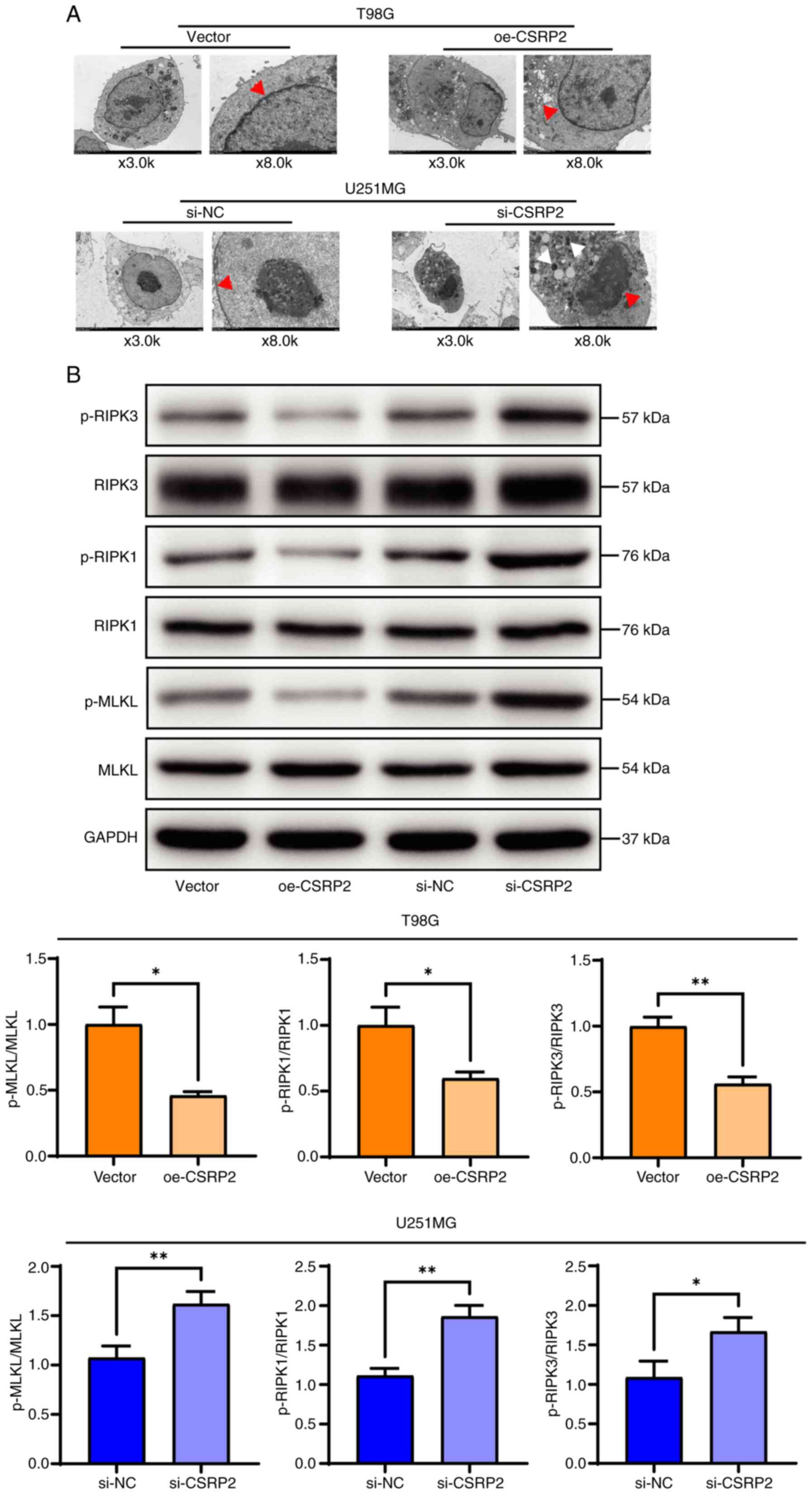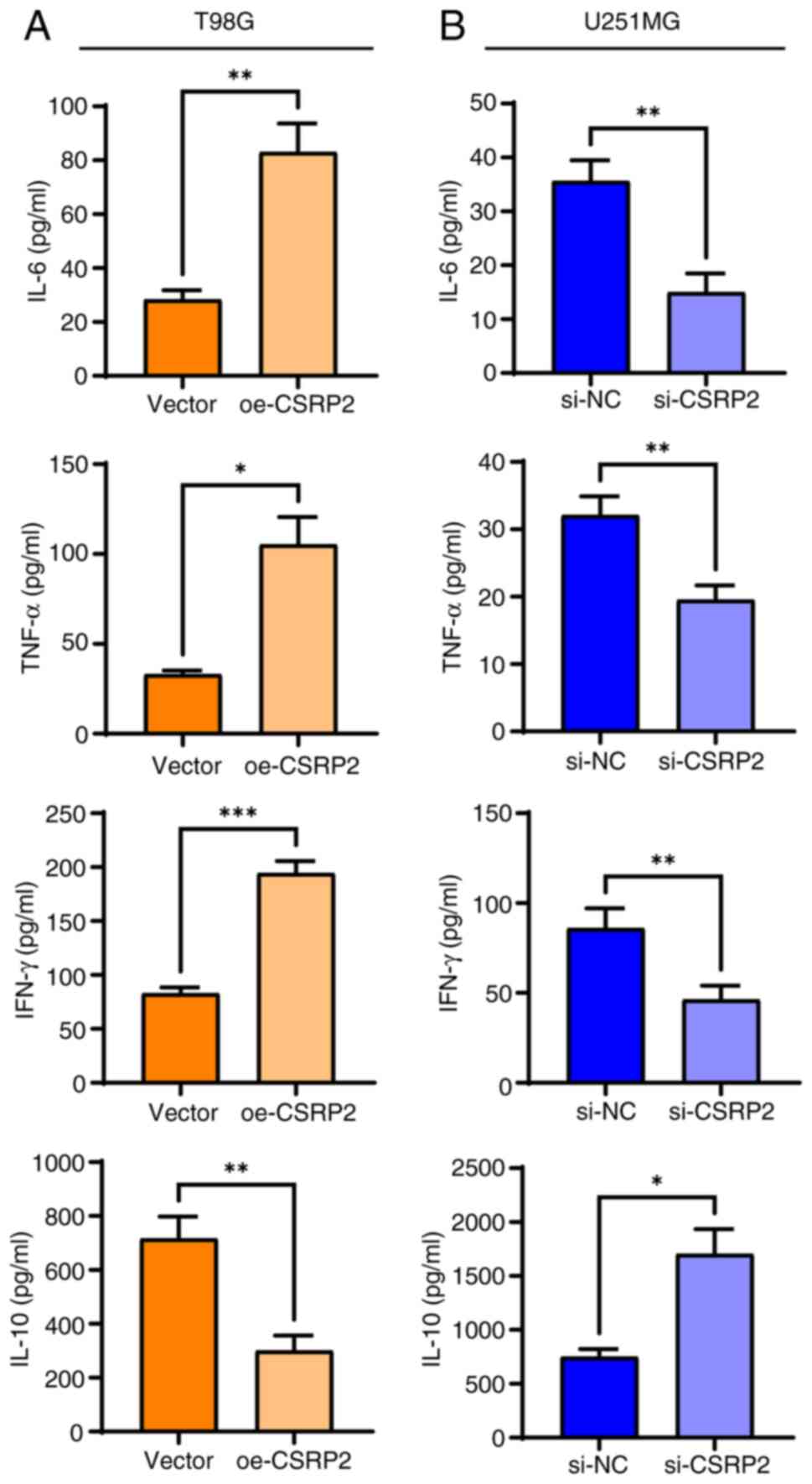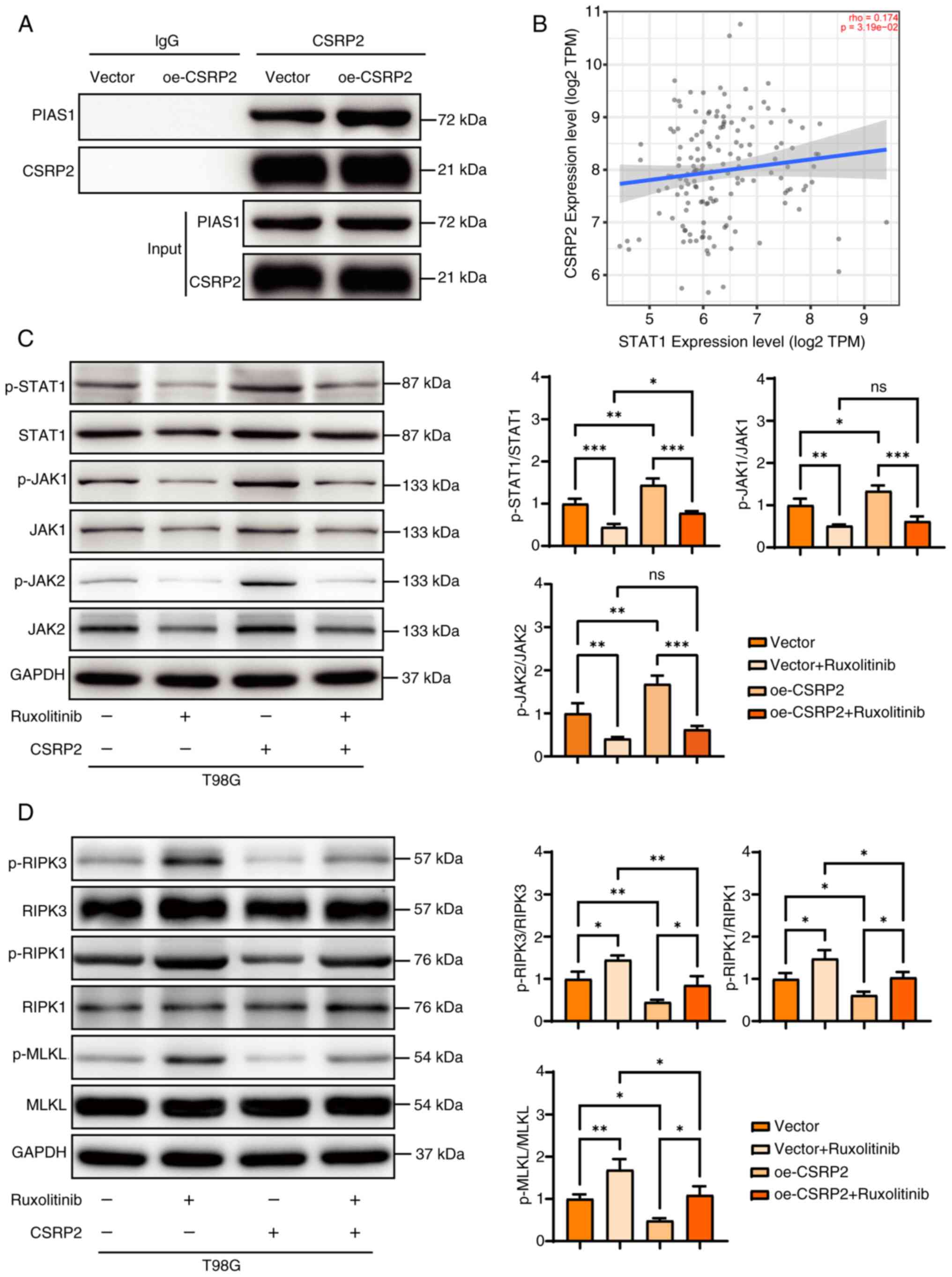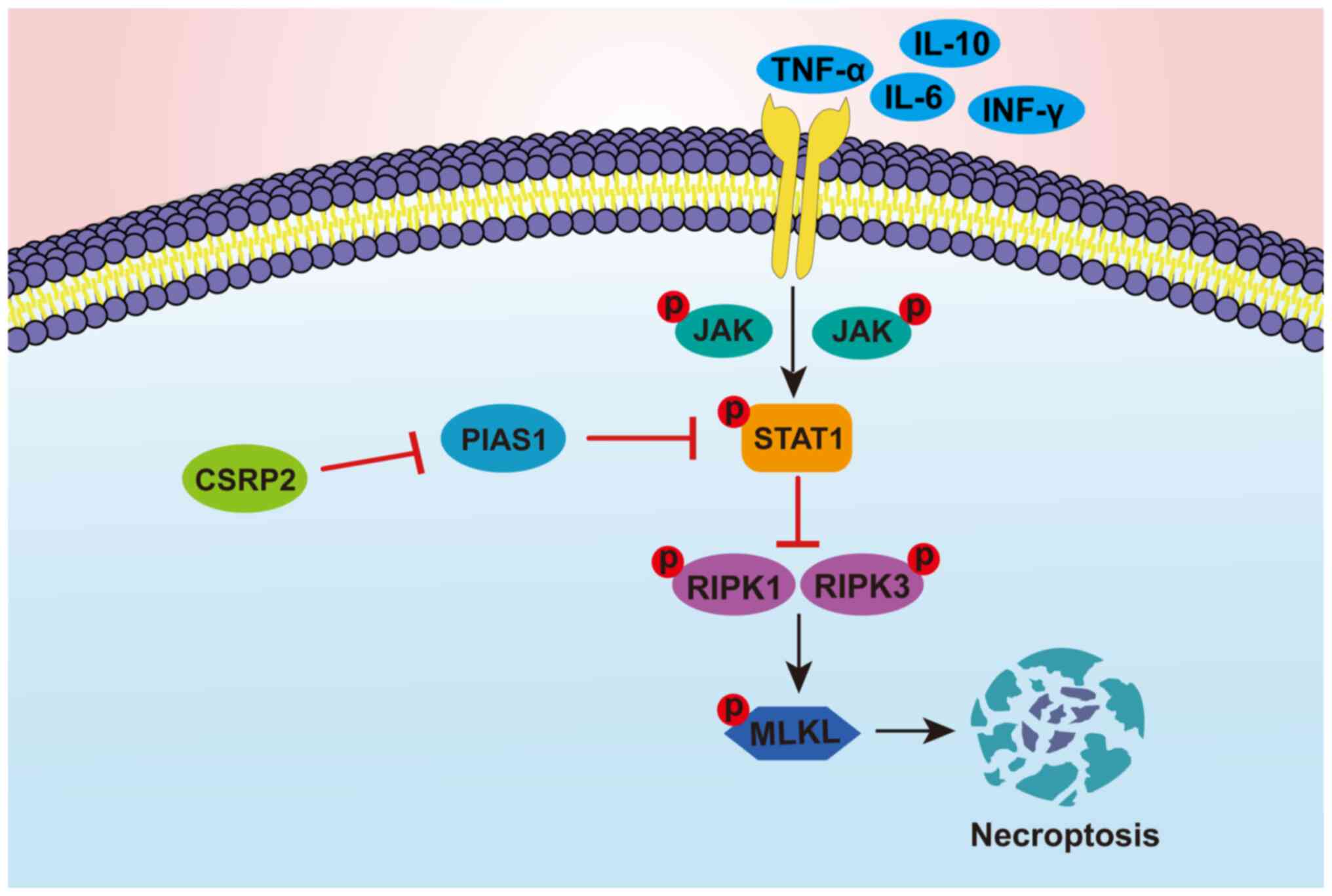Cysteine‑ and glycine‑rich protein 2: A vital regulator that inhibits necroptosis glioma cell by activating the JAK‑STAT1 pathways
- Authors:
- Published online on: February 6, 2025 https://doi.org/10.3892/or.2025.8873
- Article Number: 40
-
Copyright: © Lv et al. This is an open access article distributed under the terms of Creative Commons Attribution License.
Abstract
Introduction
Glioma is a common primary tumor of the central nervous system with a high degree of malignancy and has long been a key issue in neuro-oncology research (1). Gliomas can be divided into low-grade (grades I and II) and high-grade gliomas (grades III and IV) according to the cell morphology and growth state (2). Gliomas are extremely heterogeneous, and their tumor cells can proliferate rapidly, invade normal brain tissue, and show strong resistance to traditional treatments (3). Despite resection, radiotherapy and chemotherapy, the prognosis of most patients remains poor (4). Therefore, studying the molecular mechanisms of gliomas and the tumor microenvironment has become an effective means of monitoring and treating tumors (5).
Cysteine- and glycine-rich protein 2 (CSRP2) is an intracellular protein belonging to the CSRP family. It contains specific LIM-only domains and a conserved amino acid sequence (6). CSRP2 is involved in several intracellular processes (7). CSRP2 maintains the structure of cardiomyocytes (8) and fibroblasts (9). Additionally, CSRP2 inhibits the migration of vascular smooth muscle cells to prevent the occurrence of occlusive vascular diseases (10,11). In recent years, the role of CSRP2 in tumors has begun to receive attention, and it has been shown to play different roles in different tumors. It is upregulated in most malignant tumors, such as breast cancer (12) and head and neck squamous cell carcinoma (13). Hoffmann et al (12) reported that CSRP2 promotes the invasion of breast cancer cells in a hypoxia-induced tumor cell model. However, the opposite is true in colorectal and gastric cancers (9,14). For example, Chen et al (14) found that CSRP2 inhibits the progression of colorectal cancer by inhibiting epithelial-mesenchymal transition in colorectal cancer cells. This phenomenon may be a self-regulatory mechanism within tumor cells that inhibits tumor growth and spread. However, the specific mechanism of action remains unclear. Therefore, it is important to explore the molecular mechanisms of CSRP2 in the survival and metabolism of tumor cells.
Materials and methods
Bioinformatics analysis
TCGA RNA-seq transcriptome data were downloaded from ucscxena (https://xenabrowser.net/). The expression levels of CSRP2 in primary tumors, recurrent tumors, and normal tissues were analyzed, and the correlation between the expression levels of CSRP2 and STAT1 in gliomas was analyzed using the TNMplot database (https://tnmplot.com/analysis/). Gene expression levels in different cell lines were obtained from the Cancer Cell Line Encyclopedia (https://sites.broadinstitute.org/ccle/).
Clinical samples
All samples were collected from the Department of Neurosurgery at the Second Hospital of Hebei Medical University from August to October 2024. Inclusion criteria for patients with glioma were as follows: Diagnosed with glioma and meeting surgical indications; and glioma with obvious compression symptoms and recommended surgical resection according to guidelines; patients with other neurological neoplasms and secondary operations were excluded; and no history of surgery in the past year. Exclusion criteria for glioma patients were as follows: history of diabetes, severe hypertension, or other cardiovascular and cerebrovascular diseases and immune system diseases; history of hepatitis, syphilis, HIV and other infectious diseases; a history of acute and chronic infection; and preoperative radiotherapy, chemotherapy and biological therapy having been performed. According to the WHO grading standard, patients were divided into six cases of grade II, six cases of grade III, and six cases of grade IV. Inclusion criteria of control group were as follows: Diagnosis of hypertensive cerebral hemorrhage, arteriovenous malformation, brain trauma, epilepsy and surgical treatment; no primary tumor; and no history of surgery in the past year. Patients or family members sign informed consent forms. Exclusion criteria for control group were as follows: History of diabetes, tumor and immune system disease; a history of hepatitis, syphilis, HIV and other infectious diseases; history of acute and chronic infection; and preoperative radiotherapy, chemotherapy and biological therapy having been performed. In total, six tumor-free specimens of volunteers were obtained from patients who underwent brain surgery after trauma. The age range of the patients was 18-65 years, including 15 men and 9 women. The present study was approved (approval no. 2024-R613) by the Research Ethics Committee of the Second Hospital of the Hebei Medical University (Shijiazhuang, China). Informed consent was obtained from all the patients in accordance with the ethical principles of the Declaration of Helsinki.
Cell culture
One normal human astrocyte (NHA) and five human glioma cell lines (AM-38, T98G, U251MG, A-172 and U138MG) were used in the present study. NHA (cat. no. H10834) and AM-38 (cat. no. YS3265C) cell lines were purchased from Shanghai yaji Biotechnology Co., Ltd. The T98G (cat. no. CL-0583), U251MG (cat. no. CL-0237) and A-172 (cat. no. CL-0012) cell lines were purchased from Procell Life Science & Technology Co., Ltd., while the U138MG (cat. no. SNL-485) cell line was purchased from Wuhan Sunncell Biotechnology Co., Ltd. NHA, T98G, U251MG, A-172, and U138MG cells were cultured in Dulbecco's Modified Eagle's medium (cat. no. C3113-0500; Shanghai VivaCell Biotechnology Co. Ltd.) + 10% fetal bovine serum (FBS) (cat. no. A5670701; Thermo Fisher Scientific, Inc.) and 1% penicillin/streptomycin (cat. no. p1400; Beijing Solarbio Science & Technology Co., Ltd), while AM-38 cells were cultured in Eagle's minimal essential medium with 20% heat-inactivated FBS. The cells were cultured at 37°C and 5% CO2. To verify the role of JAK-STAT1 signaling pathway on necroptosis of glioma cells, 5 µM Ruxolitinib (cat. no. INCB18424; MedChemExpress) was used to treat cells.
Gene overexpression
The CSRP2 gene fragment was amplified by PCR using the primers listed in Table SI. BamHI (cat. no. 1010A) and EcoRI (cat. no. 1040A; both from Takara Bio, Inc.) were used for enzyme digestion of the target gene fragment and pcDNA3.1 vector (cat. no. V79020; Thermo Fisher Scientific, Inc.), respectively. The concentration of plasmid used in transient transfection was 0.5 µg/µl. The recombinant vector was constructed using T4 ligase (cat. no. EL0011; Thermo Fisher Scientific, Inc.). The conjugates were transformed into receptive Escherichia coli (cat. no. 18265017; Thermo Fisher Scientific, Inc.) and subsequently screened for recombinant vectors using a culture medium containing antibiotics. Lipofectamine 3000 Transfection Reagent (cat. no. L3000001; Thermo Fisher Scientific, Inc.) was prepared in Opti-MEM medium when the T98G cell density reached 80%. The overexpressed vector plasmid was supplemented with the P3000 reagent, and then mixed with Lipofectamine 3000 reagent in a 1:1 ratio to form the DNA liposome complex. The DNA liposome complex was added to the T98G cells and incubated at 37°C for 2 days to achieve overexpression of CSRP2. The overexpression efficiency was confirmed using reverse transcription-quantitative PCR (RT-qPCR) and western blotting.
Gene knockdown
The si-CSRP2 and si-NC sequences were synthesized by Sangon Biotech Co., Ltd. as listed in Table SII. When the U251MG cells density reached 80%, transfection was initiated using Lipofectamine 3000 Transfection Reagent diluted in Opti-MEM medium. The siRNA was dissolved in 25 µl of Opti-MEM medium to achieve a final concentration of 2 nM. Small interfering RNA (siRNA) was mixed with Lipofectamine 3000 reagent and incubated at 25°C for 20 min to allow the formation of a DNA liposome complex. The DNA liposome complex was added to the U251MG cells and incubated at 37°C for 48 h to facilitate gene knockdown. The knockdown efficiency was verified using RT-qPCR and western blotting.
Transcriptome sequencing
U251MG cells successfully transfected with si-CSRP2 were selected as the treatment group (n=3), and U251MG cells as the control group (n=3). Total RNA was extracted using a TRIzol Plus RNA Purification Kit (cat. no. 12183555; Thermo Fisher Scientific, Inc.). The concentration and purity of total RNA were detected by microspectrophotometer (cat. no. NanoDrop 2000; Thermo Fisher Scientific, Inc.). RNA integrity was detected by Agilent RNA 6000 Nano kit (cat. no. 5067-1511; Agilent Technologies. Inc.). In total, 1 µg of total RNA was selected to construct a cDNA library using the NEBNext Ultra II RNA Library Prep Kit for Illumina (cat. no. E7770S; New England Biolabs, Inc.). Initially, the insert size of the library was assessed with the Agilent 2100 Bioanalyzer (cat. no. 5991-3323EN; Agilent Technologies Inc.). Then the effective concentration of the library was accurately quantified by qPCR (the effective concentration of the library >2 nM). The mixed libraries were sequenced by PE150S double-ended on Illumina sequencers (cat. no. Novaseq 6000; Illumina, Inc.), and the nucleic acid length was 300-400 bp. The fastp (v0.22.0; http://github.com/OpenGene/fastp) software was first used to filter the sequencing data to obtain Clean data. Then HISAT2 (v2.1.0; http://daehwankimlab.github.io/hisat2/download/) was sued to map the filtered reads to the reference genome. HTSeq (v0.9.1; http://htseq.readthedocs.io/en/release_0.9.1/install.html) was used to count the number of reads aligned to each gene. The expression levels were normalized using the TPM method. Finally, DESeq2 (v1.46.0; http://bioconductor.org/packages/release/bioc/html/DESeq2.html) software was used for differential expression analysis between the two comparative groups. Differentially expressed genes were screened with |log2FC|>1.5 and P<0.05 as threshold values. The transcriptome data has been submitted to the NCBI Sequence Read Archive database (https://www.ncbi.nlm.nih.gov/sra) under accession number PRJNA1146801. Individual sample run accession numbers include SRR30206129, SRR30206130, SRR30206131, SRR30206132, SRR30206133 and SRR30206134.
Functional enrichment analysis of differential genes
Gene ontology (GO) functional enrichment was used to analyze the biological functions that differentially expressed genes (DEGs) may participate in. The Kyoto Encyclopedia of Genes and Genomes (KEGG; http://www.genome.jp/kegg/) was used to count the number of DEGs contained in different levels of the pathway and finally determine the metabolic and signaling pathways involved in the DEGs.
RT-qPCR
Cells in different groups were removed from the culture medium, 1 ml Redzol (cat. no. FTR-50; SBS Genetech Co., Ltd.) was added to the lysed cells, and RNA was extracted according to the manufacturer's protocol. The extracted RNA was reverse-transcribed to cDNA using a PrimeScript RT Reagent Kit (cat. no. RR037Q; Takara Bio, Inc.). The reaction system used was as follows: In total, 2 µl 5X PrimeScript Buffer, 0.5 µl PrimeScript RT Enzyme Mix I, 0.5 µl Oligo dT Primer, 0.5 µl Random 6-mers and 1 µg Total RNA were supplemented with RNase-free dH2O to 10 µl. Reverse transcription reaction conditions according to the manufacturer's protocol; and the product was preserved at −20°C. RT-qPCR was performed using the TB Green Premix Ex Taq II (cat. no. RR820Q; Takara Bio, Inc.). The reaction system was as follows: 10 µl TB Green Premix Ex Taq II, 0.8 µl PCR Forward Primer, 0.4 µl ROX Reference Dye, 2 µl DNA template, 6 µl sterilized water. The reaction conditions were as follows: 95°C for 30 sec, (95°C for 5 sec, and 60°C for 30 sec) ×40 cycles. GAPDH was used as reference gene. The primers used in the experiment are listed in Table SIII. The results were calculated according to the 2−ΔΔcq method (15).
Western blotting
RIPA lysate (250 µl; cat. no. C1055; Applygen Technologies, Inc.) was added to the cells collected by centrifugation, placed in an ice bath for 10 min, and centrifuged at 8,000 × g for 10 min at 4°C to collect the supernatant. The protein concentration was determined using a BCA protein concentration determination kit (cat. no. BL521A; Biosharp Life Sciences). Proteins (20 µg) were separated using SDS-PAGE (10% polyacrylamide gel) and transferred to PVDF membranes (cat. no. 03010040001; Merck KGaA). Membranes were then incubated with 5% skim milk powder (cat. no. D8340; Beijing Solarbio Science & Technology Co., Ltd.) for 2 h at 25°C. The closed PVDF membrane was incubated overnight at 4°C with a primary antibody working solution. The HRP-conjugated secondary antibody working solution was then incubated at 25°C for 1 h. Finally, an ECL chemiluminescence reagent (cat. no. BL520A; Biosharp Life Sciences) was added to visualize the bands in the gel imaging system. The antibody information used in the experiment is included in Table SIV. Densitometric analysis was conducted using the ImageJ software (version 1.52p; National Institutes of Health).
Hematoxylin and eosin staining
The 5-µm-thick tissue sections were placed on slides; slices were placed in xylene I (cat. no. 1330-20-7; Sigma-Aldrich; Merck KGaA) for 10 min, and for 5 min in xylene II, then dewaxed. Slices were then subjected to ethanol hydration (cat. no. 64-17-5; Sigma-Aldrich; Merck KGaA) and added to distilled water. The slices were stained with a hematoxylin dye solution (cat. no. C0105S; Beyotime Institute of Biotechnology) for 5 min, and then rinsed with tap water to remove the excess dye. The cells were differentiated with 1% hydrochloric alcohol (cat. no. 7647-01-0; Sigma-Aldrich; Merck KGaA) for 30 sec until the nuclei were of a suitable color and washed with tap water. The sections were placed in ammonia solution (cat. no. 1336-21-6; Sigma-Aldrich; Merck KGaA) until turned blue. The slices were placed in an eosin dye solution and stained for 3 min at 25°C; they were then dehydrated with ethanol at different concentrations and made transparent in xylene I and II. The samples were sealed with a neutral gum (cat. no. E675007-0100; Sangon Biotech Co., Ltd.).
Immunohistochemistry
The tissue sections were placed on slides. The slices were then incubated in an oven at 60°C for 30 min. Xylene I and II were soaked for dewaxing. Then, sections were hydrated with ethanol at different concentration gradients, and thermal antigen repair was performed (cat. no. C1032; Beijing Solarbio Science & Technology Co., Ltd.). The sections were incubated with a 3% hydrogen peroxide solution (cat. no. MM0750; Changzhou Maokang Medical Products Co., Ltd.) for 10 min. The sections were incubated with 10% goat serum blocking solution (cat. no. SL038; Beijing Solarbio Science & Technology Co., Ltd.) in a wet box at 25°C for 10 min. Specific primary antibody (1:1,000; cat. no. 10892-AP; Proteintech Group, Inc.) was added and incubated overnight in a wet box at 4°C. The labeled Goat anti-rabbit IgG H&L (HRP) (1:1,000; cat. no. ab6721; Abcam) was then added and incubated at 25°C for 10 min. DAB developing agent (cat. no. DA1010; Beijing Solarbio Science & Technology Co., Ltd.) was added for the color reaction. Nuclei were stained with hematoxylin for 2 min. The samples were dehydrated using an ethanol gradient and made transparent with xylene. The sections were scanned using a pathology slide scanner (cat. no. PRECICE 500; Beijing UNIC Technology Co., Ltd.).
Cell Counting Kit-8 (CCK-8)
Transfected T98G and U251MG cells were treated with trypsin digestion solution (cat. no. C0201; Beyotime Institute of Biotechnology) and incubated for 2 min. The medium was then added, and the cells were suspended in a centrifuge tube (1,200 × g) and centrifuged for 3 min at 25°C. The cell density was calculated using a cell counter (cat. no. A50298; Thermo Fisher Scientific, Inc.). The cells were inoculated into 96-well plates at 2,000 PCS/well. After incubation at 37°C for 0, 24, 48 and 72 h, 10 µl of CCK-8 was added to each well of the 96-well plate and incubated for 4 h. The absorbance of each well was measured at 450 nm using an enzyme labeler.
EdU assay
The RiboBio EdU Cell Proliferation Assay Kit (cat. no. C10310; Guangzhou RiboBio Co., Ltd.) was used. Cells at the logarithmic growth stage were inoculated into 96-well plates at a density of 4,000 cells/well. Diluted EdU solution (100 µl) was added to each well and incubated for 2 h at 37°C. The culture medium was discarded, and 50 µl of cell-fixing solution was added to each well and incubated at 25°C for 30 min. The fixing solution was discarded, 100 µl of penetrant was added to each well, and incubated at 25°C for 10 min. Apollo staining solution (100 µl) was added to each well and incubated at 25°C for 30 min. The dye reaction solution was discarded, 100 µl of penetrant solution was added, and the mixture was washed twice for 10 min each time. Osmotic fluid was discarded. A total of 100 µl of 1X Hoechst 33342 reaction solution was added to each well and incubated at 25°C for 30 min. The dye reaction solution was discarded, and 100 µl PBS was added for washing twice. After sealing with an anti-fluorescence quenched tablet, it was stored at 4°C in the dark.
Cell healing experiment
When the cells in the dish formed a monolayer, a sterile gun tip was used to create a vertical scratch on the monolayer. The cells were washed with PBS and added to a serum-free medium. The cell status at 0 h was immediately recorded using an inverted microscope. The cells were cultured in a petri dish for 48 and 96 h and then images were captured using an inverted microscope. The healing rate was expressed as a proportion of the change in the width of the scratch, and the healing rate of the cells was calculated for 48 h.
Transwell assay
In total, 100 µl of matrix glue was uniformly applied to the upper chamber of the Transwell cell (cat. no. 3378; Corning, Inc.). After solidification, 5×105 cells were inoculated in the upper chamber, and 500 µl of medium containing 20% FBS was added to the lower chamber. The cells were cultured in an incubator for 48 h at 37°C. The cells were removed and fixed with 600 µl of fixative solution (cat. no. P1110; Beijing Solarbio Science & Technology Co., Ltd.) for 30 min. The fixing solution was then discarded, and 0.2% crystal violet (cat. no. C8470; Beijing Solarbio Science & Technology Co., Ltd.) was added for staining for 10 min. The number of cells that crossed the membrane and reached the lower chamber was observed under the inverted biological microscope (cat. no. ICX41; Ningbo Sunny Instruments Co., Ltd.).
Hoechst 33342/PI dual staining
The cells were then digested, collected and counted. A total of 105 cells were suspended in a medium containing 5 µl Hoechst and 5 µl PI staining solutions (cat. no. BL116A; Biosharp Life Sciences) and incubated at 4°C for 30 min. The cells were collected using centrifugation at 1,200 × g for 3 min and stained to observe the red and blue fluorescence.
Flow cytometry
The Annexin V-FITC/PI Apoptosis Detection Kit (cat. no. 40302ES20; Shanghai Yeasen Biotechnology Co., Ltd.) was used to detect apoptotic cells. The cells were digested using ethylene-diamine-tetra-acetic acid-free pancreatic enzymes (cat. no. C0205; Beyotime Institute of Biotechnology) and collected. Cells (1×105) were selected, and 100 µl of Binding Buffer was added to the cells. Staining Solution with 5 µl Annexin V-FITC and 10 µl PI was mixed and stained at 25°C for 10 min. A 400 µl 1X Binding Buffer was added and detected by flow cytometry (cat. no. A24858; Thermo Fisher Scientific, Inc.). Data analysis was performed using FlowJo software (version 10.8.1; FlowJo LLC).
Transmission electron microscopy
The transfected cells were collected, and the cell structure was fixed at 4°C for 2 h using 2.5% electron microscope fixation solution (cat. no. G1102; Wuhan Servicebio Biotechnology Co., Ltd.). A solution of 1% agarose (cat. no. 10208ES60; Shanghai Yeasen Biotechnology Co., Ltd.) was prepared, and the cell precipitates were embedded in agarose. Then, 1% osmic acid (cat. no. RBS0086; Shanghai Rongbai biological technology Co., Ltd.) was added to avoid light at 25°C for 2 h. Gradient ethanol concentrations were used for dehydration. Acetone and 812 embedding agents [cat. no. SPI-02660; HEAD (BEIJING) Biotechnology Co., Ltd.] were used for infiltration embedding. The embedded plates were incubated at 60°C for 48 h. Ultrathin slices (60 nm) were prepared using an ultrathin microtome (ARTOS 3D; Leica Microsystems GmbH). A 2% uranium acetate-saturated alcohol solution (cat. no. 541-09-3; Hubei Shixing Chemical Co., Ltd.) was used to avoid light staining for 8 min and a 2.6% lead citrate solution (cat. no. 77-92-9; Shanghai Aladdin Biochemical Technology Co., Ltd) was used to avoid carbon dioxide staining for 8 min. Spectra Ultra S/TEM (Thermo Fisher Scientific, Inc.) was used for observation, image collection and analysis.
ELISA
Cytokines IL-6 (cat. no. EK1153), TNF-α (cat. no. EK182HS), IFN-γ (cat. no. EK180HS) and IL-10 (cat. no. EK110/2) were all purchased from Hangzhou Lianke Biotechnology Co., Ltd. The absorbance was measured using a full-wavelength enzyme labeler (Multiskan SkyHigh; Thermo Fisher Scientific, Inc.).
Co-immunoprecipitation (Co-IP)
An immunoprecipitation kit (cat. no. P2179S; Beyotime Institute of Biotechnology) was for the experiments. Transfected cells were collected and lysed on ice, and the supernatant was collected. For every 500 µg of total protein lysate, 20 µl of Protein A/G Agarose slurry was added and incubated at 25°C for 2 h. Primary antibody (1 µg) was added to the remaining lysate and incubated at 4°C overnight. Pre-treated Protein A/G agarose beads were added and incubated at 4°C for 2 h. The beads were collected using centrifugation at 1,000 × g at 4°C for 3 min and rinsed with the elution buffer. Western blotting was performed on the eluent to analyze the coprecipitated proteins. The primary antibodies used were anti-CSRP2 (1:1,000; cat. no. 10892-AP; Proteintech Group, Inc.) and anti- protein inhibitor of activated STAT1 (PIAS1) (1:1,000; cat. no. ab109388; Abcam).
Correlation analysis of gene expression
The TIMER 2.0 database (http://cistrome.org/TIMER/) was used for analysis CSRP2 and pertinence of STAT1 in glioma. Gene Correlation analysis was selected in the Cancer Exploration module. The restrictions were set to CSRP2, STAT1 and glioma. Spearman rank correlation coefficient was used to analyze the correlation of gene expression.
Statistical analyses
Statistical analysis of the experimental results was performed using the ImageJ software (version 1.52p; National Institutes of Health). GraphPad Prism software (version 9; Dotmatics) was used for data analysis. Statistical differences between two groups of data were analyzed using the unpaired t-test, and other data were analyzed using one-way ANOVA. The Tukey's Honestly Significant Difference test was then used to compare the significant differences between the groups. The Spearman rank correlation coefficient was used to determine the correlation between genes. P<0.05 was considered to indicate a statistically significant difference.
Results
CSRP2 is upregulated in glioma
TCGA RNA-seq transcriptome data were downloaded from the UCSC Xena website (https://xena.ucsc.edu/). The expression levels of CSRP2 in both recurrent and primary tumors were significantly higher than that in normal tissues (Fig. 1A). Tissues were further collected from patients with glioma, and RT-qPCR results demonstrated that CSRP2 expression levels in glioma were significantly higher than those in normal tissues, and CSRP2 expression showed an increasing trend with tumor grade (Fig. 1B). Western blotting revealed similar results (Fig. 1C). Hematoxylin and eosin staining were used to evaluate inflammation in the glioma tissues. Different degrees of inflammatory cell aggregation and infiltration were observed in glioma tissues of different grades (Fig. 1D). CSRP2 content was detected using immunohistochemical staining. It was observed that CSRP2 was positively expressed in glioma tissues, with the highest positivity rate observed in grade IV tumors (Fig. 1E).
CSRP2 promotes the proliferation, migration and invasion of glioma cells
To explore the effects of CSRP2 on the biological function of glioma cells, The Cancer Cell Line Encyclopedia was used to screen glioma cell lines. A total of five glioma cell lines and one human astrocyte NHA cell line were selected for the RT-qPCR analysis. The results showed that the expression levels of CSRP2 in glioma cells was significantly higher than that in NHA cells (Fig. 2A). Therefore, U251MG cells with the highest CSRP2 expression levels were selected for gene knockdown experiments and T98G cells with the lowest expression levels were selected for gene overexpression experiments. In total, three candidate siRNAs were designed and RT-qPCR was used to determine the efficiency of the gene knockdown. Finally, si-CSRP2-1 was selected for gene knockdown experiments in U251MG cells (Fig. 2B). The overexpression and knockdown effects of CSRP2 in cells were verified using western blotting (Fig. 2C).
CCK-8 results identified that overexpression of CSRP2 improved the viability of NHA cells, whereas CSRP2 knockdown had no significant effect on NHA cell viability (Fig. 3A). The viability of glioma cells was then assessed. It was found that CSRP2 overexpression significantly increased the viability of T98G cells, whereas CSRP2 downregulation inhibited the viability of U251MG cells (Fig. 3B). EdU experiments further revealed that CSRP2 overexpression promoted the proliferation of T98G cells, whereas CSRP2 knockdown inhibited the proliferation of U251MG cells (Fig. 3C). The results of the wound healing (Fig. 3D) and Transwell (Fig. 3E) assays showed that overexpression of CSRP2 promoted the invasion and migration of T98G cells, whereas knockdown of CSRP2 revealed the opposite results.
CSRP2 inhibits necroptosis of glioma cells
CSRP2 expression in U251MG cells was knocked down and transcriptome sequencing was performed. Principal component analysis revealed that the control and glioma cell groups clustered significantly (Fig. 4A). The DEGs were screened with P<0.05 and |log 2FC|>1.5. A total of 100 upregulated and 337 downregulated genes were identified. The selected DEGs were used to create a GO chord diagram (Fig. 4B). The DEGs were mainly involved in the inflammatory pathways. Next, enrichment of KEGG signaling pathways was performed (Fig. 4C). Focus was primarily addressed on cellular processes and environmental information processing. Although the P53 signaling pathway is highly enriched in cancer, its role in cancer has been well-established, with gene therapies and targeted treatments already in place (16). Furthermore, it was observed that STAT1, a gene enriched in both necroptosis and the JAK-STAT signaling pathway, potentially links these two processes. This connection suggests that the JAK-STAT pathway may not only be a central regulatory factor in glioma biology but also a convergence point for necroptosis, offering a new perspective on the pathophysiology of gliomas. In light of these insights, it was have chosen to further explore the JAK-STAT signaling pathway in the context of gliomas, with a particular emphasis on its interaction with necroptosis.
Flow cytometric results showed that CSRP2 overexpression inhibited apoptosis of T98G cells, whereas CSRP2 knockdown increased the apoptotic rate of U251MG cells (Fig. 5A). Cells that are positive for PI staining may be in a late apoptotic or necrotic state. Compared with the control group, the necrosis rate in the overexpression (oe)-CSRP2 group was significantly reduced, whereas the necrosis rate in the si-CSRP2 group was significantly increased (Fig. 5B). Using transmission electron microscopy, it was observed that the cell membrane of U251MG cells with CSRP2 knockdown was broken incompletely, with evident nuclear shrinkage and destruction of organelles such as the mitochondria (Fig. 6A). Western blot analysis detected the expression of necroptosis-related proteins; it was found that the expression levels of the necroptosis-related proteins phosphorylated (p-)MLKL, p-RIPK1 and p-RIPK3 were significantly decreased in the oe-CSRP2 group. By contrast, the expression levels of these proteins were significantly increased in the si-CSRP2 group (Fig. 6B).
CSRP2 activates inflammation in glioma cells
Our previous analysis of transcriptome sequencing data predicted that CSRP2 knockdown may activate the inflammatory pathways. Therefore, the levels of the inflammation-related factors IL-6, TNF-α, IFN-γ and IL-10 were detected using ELISA (Fig. 7A). It was found that overexpression of CSRP2 increased the levels of the pro-inflammatory cytokines IL-6, TNF-α and IFN-γ in T98G cells, whereas the levels of the anti-inflammatory cytokine IL-10 decreased. These cytokines showed the opposite trend in U251MG cells with CSRP2 knockdown (Fig. 7B).
CSRP2 inhibits necroptosis of glioma cells by activating the JAK-STAT1 signaling pathway
CSRP2 interacts with PIAS1 (17). The binding of CSRP2 to PIAS1 was further confirmed using Co-IP (Fig. 8A). TIMER 2.0 database analysis showed that the expression of CSRP2 and STAT1 in glioma was positively correlated (rho=0.174, P=3.19×10−2) (Fig. 8B). Owing to the weak correlation between these two genes, the relationship between CSRP2 and the JAK-STAT1 pathway was further verified using western blotting. Ruxolitinib is a JAK-STAT1 pathway inhibitor that specifically targets Janus kinase 1 and 2 (JAK1/2). Overexpression of CSRP2 increased the relative expression of p-STAT1 and p-JAK1, which recovered after the addition of the pathway inhibitor Ruxolitinib (Fig. 8C). Simultaneously, the expression levels of p-JAK1, p-JAK2 and p-STAT1 in the pathway were consistent. The expression of necroptosis-related proteins was further detected using western blotting (Fig. 8D). It was found that the inhibitors of the JAK-STAT1 signaling pathway increased the expression of p-MLKL, p-RIPK1 and p-RIPK3, whereas overexpression of CSRP2 reduced the expression of these proteins. Overexpression of CSRP2 and the addition of pathway inhibitors restored the expression of these proteins to the control level. The mechanism of CSRP2 involvement in glioma cell necroptosis is displayed in Fig. 9. It was hypothesized that CSRP2 inhibits the expression of PIAS1, which maintains the JAK-STAT1 pathway in an activated state. At this time, the phosphorylation of the downstream necroptosis-related proteins RIPK1 and RIPK3 is inhibited, which directly leads to the phosphorylation of MLKL, thereby inhibiting necroptosis in glioma cells.
Discussion
There are significant differences in gene expression between tumors and normal tissues owing to the heterogeneity of gliomas (18). The present study showed that CSRP2 is upregulated to varying degrees in grade II–IV gliomas. Cell experiments further demonstrated that CSRP2 promotes the proliferation, migration and invasion of U251M and T98G glioma cells. The mechanism of action of CSRP2 differs among different tumor types. It was found that in U251M cells with CSRP2 knockdown, DEGs were enriched in cellular processes, such as necroptosis, and DEGs were significantly correlated with the JAK-STAT signaling pathway. Therefore, the molecular mechanisms underlying CSRP2 regulation of glioma necroptosis were analyzed.
Necroptosis is closely associated with the proliferation and metastasis of tumor cells (19). Necroptosis-related proteins are upregulated in breast cancer (20), hepatocellular carcinoma (21) and gastric cancer (22). Specific drugs inhibit RIPK3 and promote the proliferation and metastasis of tumor cells (23). Therefore, targeting key genes involved in necroptosis may be a new direction for cancer immunotherapy. Owing to its particularity, necroptosis is expected to overcome the resistance to apoptosis during therapy.
PIAS1 binds to STAT1, thereby inhibiting its transcriptional activation (24). Weiskirchen et al (17) reported that CSRP2 binds to PIAS1 and participates in JAK-STAT1 signal transduction. The protein interaction between CSRP2 and PIAS1 was verified through co-IP and it was found that CSRP2 overexpression promoted the phosphorylation of STAT1, JAK1 and JAK2. Therefore, it was hypothesized that CSRP2 interacts with PIAS1 to block the inhibition of PIAS1 on STAT1, thus activating the JAK-STAT1 signaling pathway.
Typically, the JAK-STAT signaling pathway is abnormally activated in various malignancies. Cytokines, such as interleukins and interferons, activate the JAK-STAT pathway via transmembrane transport into cells (25). The JAK-STAT pathway is involved in programmed cell death. Activated STAT1 and STAT3 contribute to iron death by participating in ferrimodulin expression or antioxidant system regulation (26). After activation of the JAK-STAT pathway, STAT proteins can enter the nucleus, bind to the promoter region of specific genes, and promote the expression of anti-apoptotic genes such as Bcl-2 and Mcl-1, thus inhibiting the apoptosis of tumor cells (27). CSRP2 was knocked down in U251M cells and it was found that the DEGs were enriched in cellular processes such as necroptosis. STAT1 can bind to the necroptosis pathway protein RIPK3 (28). It was identified that CSRP2 knockdown promoted necroptosis in U251M cells, resulting in nuclear condensation and cell membrane rupture, whereas phosphorylation of necroptosis proteins RIPK1, RIPK3 and MLKL was inhibited.
In reflecting on the scope and findings of the present study, it is recognized that while it has shed light on the role of CSRP2 in glioma and its potential interactions with the JAK-STAT signaling pathway, there are inherent limitations that warrant consideration. The analysis utilizing the TIMER database revealed a modest positive correlation between CSRP2 and STAT1, suggesting a possible association that may not be as robust as might be expected for key regulatory elements in glioma progression. This subtle relationship could indicate that other factors or pathways may also play significant roles in glioma biology, which the present study has not fully explored. Additionally, the research is confined to in vitro models, and the translation of these findings to in vivo settings and clinical relevance remains to be established. The sample size, while sufficient for the analyses conducted, may not capture the full diversity of glioma patient populations, which could influence the generalizability of the results. Despite these limitations, the current study provides a solid foundation for further exploration into the complex interplay of CSRP2 with other signaling elements in glioma.
Supplementary Material
Supporting Data
Acknowledgements
Not applicable.
Funding
The present study was supported by the Natural Science Foundation of Hebei (grant no. H2021206037), the Government-funded Project on Training of Outstanding Clinical Medical Personnel of Hebei in 2021 (grant no. 303-16-20-06) and the Medical Research Project of Hebei Provincial Health Commission (grant no. 20230031).
Availability of data and materials
The data generated in the present study may be requested from the corresponding author.
Authors' contributions
DL, LiqL and LiaL conceptualized the study. XH, LH and JL managed and analyzed data. DL conducted investigation and wrote the original draft. XH, ZS and AZ developed methodology and performed data visualization. ZS, AZ and LiaL provided resources. LiaL performed project administration, wrote, reviewed and edited the manuscript. All authors read and approved the final version of the manuscript. DL and LiqL confirm the authenticity of all the raw data.
Ethics approval and consent to participate
The present study was approved (approval no. 2024-R613) by the Research Ethics Committee of the Second Hospital of the Hebei Medical University (Shijiazhuang, China). Informed consent was obtained from all the patients in accordance with the ethical principles of the Declaration of Helsinki.
Patient consent for publication
Not applicable.
Competing interests
The authors declare that they have no competing interests.
References
|
van den Bent MJ, Geurts M, French PJ, Smits M, Capper D, Bromberg JEC and Chang SM: Primary brain tumours in adults. Lancet. 402:1564–1579. 2023. View Article : Google Scholar : PubMed/NCBI | |
|
Weller M, Wen PY, Chang SM, Dirven L, Lim M, Monje M and Reifenberger G: Glioma. Nat Rev Dis Primers. 10:332024. View Article : Google Scholar : PubMed/NCBI | |
|
Chai X, Zhang Y, Zhang W, Feng K, Jiang Y, Zhu A, Chen X, Di L and Wang R: Tumor metabolism: A new field for the treatment of glioma. Bioconjug Chem. 35:1116–1141. 2024. View Article : Google Scholar : PubMed/NCBI | |
|
Obrador E, Moreno-Murciano P, Oriol-Caballo M, López-Blanch R, Pineda B, Gutiérrez-Arroyo JL, Loras A, Gonzalez-Bonet LG, Martinez-Cadenas C, Estrela JM and Marqués-Torrejón MÁ: Glioblastoma therapy: Past, present and future. Int J Mol Sci. 25:25292024. View Article : Google Scholar : PubMed/NCBI | |
|
Mishchenko TA, Turubanova VD, Gorshkova EN, Krysko O, Vedunova MV and Krysko DV: Glioma: Bridging the tumor microenvironment, patient immune profiles and novel personalized immunotherapy. Front Immunol. 14:12990642023. View Article : Google Scholar : PubMed/NCBI | |
|
Weiskirchen R and Günther K: The CRP/MLP/TLP family of LIM domain proteins: Acting by connecting. BioEssays. 25:152–162. 2003. View Article : Google Scholar : PubMed/NCBI | |
|
Schallus T, Fehér K, Ulrich AS, Stier G and Muhle-Goll C: Structure and dynamics of the human muscle LIM protein. FEBS Lett. 583:1017–1022. 2009. View Article : Google Scholar : PubMed/NCBI | |
|
Chang DF, Belaguli NS, Chang J and Schwartz RJ: LIM-only protein, CRP2, switched on smooth muscle gene activity in adult cardiac myocytes. Proc Natl Acad Sci U S A. 104:157–162. 2007. View Article : Google Scholar : PubMed/NCBI | |
|
Wang J, Guan X, Zhang Y, Ge S, Zhang L, Li H, Wang X, Liu R, Ning T, Deng T, et al: Exosomal miR-27a derived from gastric cancer cells regulates the transformation of fibroblasts into cancer-associated fibroblasts. Cell Physiol Biochem. 49:869–883. 2018. View Article : Google Scholar : PubMed/NCBI | |
|
Chen CH, Ho YC, Ho HH, Chang IC, Kirsch KH, Chuang YJ, Layne MD and Yet SF: Cysteine-rich protein 2 alters p130Cas localization and inhibits vascular smooth muscle cell migration. Cardiovasc Res. 100:461–471. 2013. View Article : Google Scholar : PubMed/NCBI | |
|
Wu ML, Chen CH, Lin YT, Jheng YJ, Ho YC, Yang LT, Chen L, Layne MD and Yet SF: Divergent signaling pathways cooperatively regulate TGFbeta induction of cysteine-rich protein 2 in vascular smooth muscle cells. Cell Commun Signal. 12:222014. View Article : Google Scholar : PubMed/NCBI | |
|
Hoffmann C, Mao X, Brown-Clay J, Moreau F, Al Absi A, Wurzer H, Sousa B, Schmitt F, Berchem G, Janji B and Thomas C: Hypoxia promotes breast cancer cell invasion through HIF-1alpha-mediated up-regulation of the invadopodial actin bundling protein CSRP2. Sci Rep. 8:101912018. View Article : Google Scholar : PubMed/NCBI | |
|
Zhang MJ, Liu J, Wan SC, Li JX, Wang S, Fidele NB, Huang CF and Sun ZJ: CSRP2 promotes cell stemness in head and neck squamous cell carcinoma. Head Neck. 45:2161–2172. 2023. View Article : Google Scholar : PubMed/NCBI | |
|
Chen L, Long X, Duan S, Liu X, Chen J, Lan J, Liu X, Huang W, Geng J and Zhou J: CSRP2 suppresses colorectal cancer progression via p130Cas/Rac1 axis-meditated ERK, PAK, and HIPPO signaling pathways. Theranostics. 10:11063–11079. 2020. View Article : Google Scholar : PubMed/NCBI | |
|
Livak KJ and Schmittgen TD: Analysis of relative gene expression data using real-time quantitative PCR and the 2-(−Delta Delta C(T)) method. Methods. 25:402–408. 2001. View Article : Google Scholar : PubMed/NCBI | |
|
Huang J: Current developments of targeting the p53 signaling pathway for cancer treatment. Pharmacol Ther. 220:1077202021. View Article : Google Scholar : PubMed/NCBI | |
|
Weiskirchen R, Moser M, Weiskirchen S, Erdel M, Dahmen S, Buettner R and Gressner AM: LIM-domain protein cysteine- and glycine-rich protein 2 (CRP2) is a novel marker of hepatic stellate cells and binding partner of the protein inhibitor of activated STAT1. Biochem J. 359:485–496. 2001. View Article : Google Scholar : PubMed/NCBI | |
|
Śledzińska P, Bebyn MG, Furtak J, Kowalewski J and Lewandowska MA: Prognostic and predictive biomarkers in gliomas. Int J Mol Sci. 22:103732021. View Article : Google Scholar : PubMed/NCBI | |
|
Tong X, Tang R, Xiao M, Xu J, Wang W, Zhang B, Liu J, Yu X and Shi S: Targeting cell death pathways for cancer therapy: Recent developments in necroptosis, pyroptosis, ferroptosis, and cuproptosis research. J Hematol Oncol. 15:1742022. View Article : Google Scholar : PubMed/NCBI | |
|
Huang FY, Dai SZ, Xu WT, Xiong W, Sun Y, Huang YH, Wang JY, Lin YY, Chen H, Tan GH and Zheng WP: 3′-epi-12beta-hydroxyfroside-mediated autophagy degradation of RIPK1/RIPK3 necrosomes leads to anergy of immunogenic cell death in triple-negative breast cancer cells. Pharmacol Res. 187:1066132023. View Article : Google Scholar : PubMed/NCBI | |
|
Pomlok K, Pata S, Kulaphisit M, Pangnuchar R, Wipasa J, Smith DR, Kasinrerk W and Lithanatudom P: An IgM monoclonal antibody against domain 1 of CD147 induces non-canonical RIPK-independent necroptosis in a cell type specific manner in hepatocellular carcinoma cells. Biochim Biophys Acta Mol Cell Res. 1869:1192952022. View Article : Google Scholar : PubMed/NCBI | |
|
Vetrivel P, Nachimuthu S, Abuyaseer A, Bhosale PB, Ha SE, Kim HH, Park MY and Kim GS: Investigation on the cellular mechanism of prunetin evidenced through next generation sequencing and bioinformatic approaches against gastric cancer. Sci Rep. 12:118522022. View Article : Google Scholar : PubMed/NCBI | |
|
Wang HL, Chang JC, Fang LW, Hsu HF, Lee LC, Yang JF, Liang MT, Hsiao PC, Wang CP, Wang SW, et al: Bulnesia sarmientoi supercritical fluid extract exhibits necroptotic effects and anti-metastatic activity on lung cancer cells. Molecules. 23:33042018. View Article : Google Scholar : PubMed/NCBI | |
|
Liu B, Mink S, Wong KA, Stein N, Getman C, Dempsey PW, Wu H and Shuai K: PIAS1 selectively inhibits interferon-inducible genes and is important in innate immunity. Nat Immunol. 5:891–898. 2004. View Article : Google Scholar : PubMed/NCBI | |
|
Xue C, Yao Q, Gu X, Shi Q, Yuan X, Chu Q, Bao Z, Lu J and Li L: Evolving cognition of the JAK-STAT signaling pathway: Autoimmune disorders and cancer. Signal Transduct Target Ther. 8:2042023. View Article : Google Scholar : PubMed/NCBI | |
|
Chen Y, Fang ZM, Yi X, Wei X and Jiang DS: The interaction between ferroptosis and inflammatory signaling pathways. Cell Death Dis. 14:2052023. View Article : Google Scholar : PubMed/NCBI | |
|
Vier J, Groth M, Sochalska M and Kirschnek S: The anti-apoptotic Bcl-2 family protein A1/Bfl-1 regulates neutrophil survival and homeostasis and is controlled via PI3K and JAK/STAT signaling. Cell Death Dis. 7:e21032016. View Article : Google Scholar : PubMed/NCBI | |
|
Yu X, Ma H, Li B, Ji Y, Du Y, Liu S, Li Z, Hao Y, Tian S, Zhao C, et al: A novel RIPK1 inhibitor reduces GVHD in mice via a nonimmunosuppressive mechanism that restores intestinal homeostasis. Blood. 141:1070–1086. 2023. View Article : Google Scholar : PubMed/NCBI |



